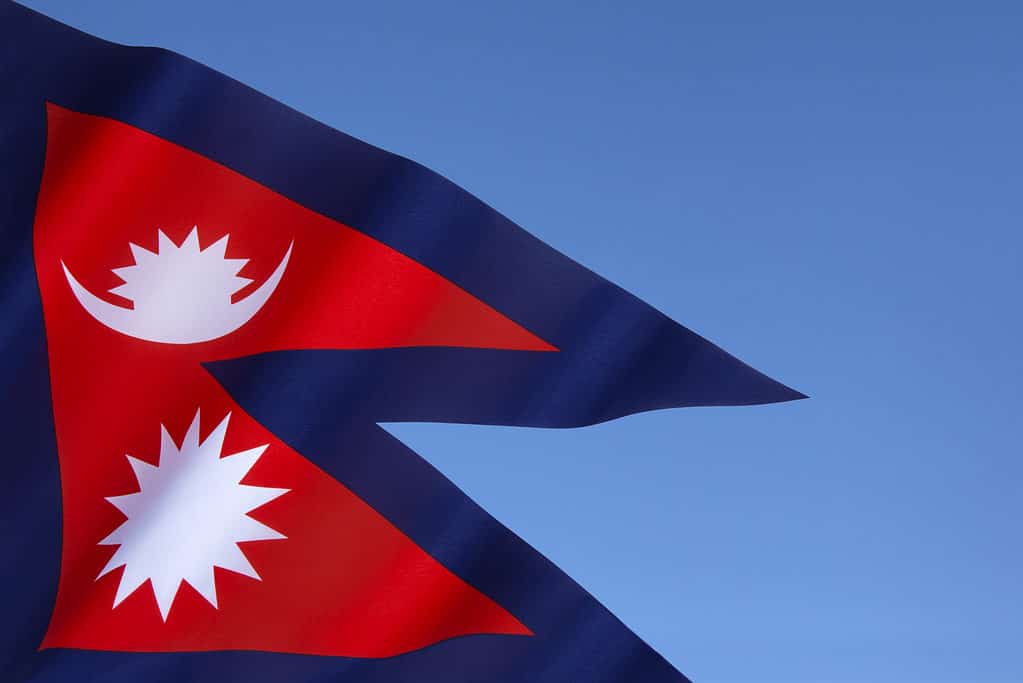Nepal’s national flag is unique in that it serves as both the civic and state flag of a sovereign country; all other national flags in the world are rectangular. The flag of Nepal is a double pennon, a streamlined version of a pennon (a single pennant). Nepal’s flag traditionally has Hindu religious symbols. Hinduism and Buddhism, the two largest religions in the country, are, nevertheless, given a more contemporary and official portrayal. Today I’m going to write a long piece about the flag of Nepal, explaining its origins, significance, and symbolism.
The Flag of Nepal History

Morning sunrise hits the mountain peak and the flag of Nepal. The flag of Nepal was updated in 1962.
©TravellingNepal/Shutterstock.com
The flag of Nepal dates back to the Vedic era. The Mahabharata and Vedas both refer to it. However, the flag’s origin in Nepal is a mystery. Nepal updated its national flag in 1962, although the alterations were subtle. Architect and designer Shankar Nath Rimal was commissioned by King Mahendra to create Nepal’s current flag.
The Current Flag of Nepal
The flag of Nepal is the only one in the world that isn’t a square or rectangle. It is a hybrid of the two separate pennons flown by competing factions of the royal dynasty. It takes inspiration from the old, conventional design that was in use during the 19th and 20th centuries. Upon King Mahendra’s suggestion, civil engineer Shankar Nath Rimal standardized the flag.
The current flag appears to be an amalgam of the flags of the former Gorkha Kingdom and the Mustang Kingdom. Mustang District in Nepal. These color gradients are a direct inspiration from the mustang kingdom. Both the sun and the moon on the flag had faces in them before 1962. Many individuals were sketching the flag improperly, thus Article I; Section 8 of the Constitution specified its exact dimensions. This part is still in effect today despite the fact that the country adopted several different constitutions over that time.
As the new constitution was being written in May 2008, several political parties proposed changing the flag because of the flag’s association with Hinduism and royalty. This was ultimately shot down.
The Flag of Nepal Design
Nepal’s flag is a nonrectilinear design made up of two triangles. The Nepalese flag features the colors red, white, and blue. Both the red background and the dark blue border are typical of Nepali art and design. The upper part features a white moon with eight beams, and the lower part is a crescent. The bottom half of the flag features a white stylized sun with 12 rays.
The Flag of Nepal Symbolism

Flag of Nepal – the world’s only non-quadrilateral national flag. Until 1962, the flags emblems, the sun, and the crescent moon, had human faces. They were removed to modernize the flag.
©Steve Allen/Shutterstock.com
Nepali art and decoration frequently feature the flag’s primary colors. Multiple interpretations have been added to the flag’s traditional symbols in recent years. The symbolic meanings of each color are explained in greater depth below.
Crimson Red:
The Heart of Nepal’s Flag is a shade of crimson. This color of red is significant in Nepalese culture since it is the hue of the Rhododendron, the country’s national flower. It also represents bravery and the country’s success in battle. The Himalayas are represented by one triangle, while the other triangle represents the two main religions practiced in Nepal (Hinduism and Buddhism). Since the times of the Ramayana and the Mahabharata, the red triangle flag has served as a symbol of triumph for Hindus.
Blue:
Because Gautama Buddha was born in Nepal, the country has enjoyed relative stability and unity since his time. This is what is represented by the flag’s blue border. S N Rimal, who developed the flag of Nepal in 1962, said that the blue outlines also symbolized the sky above the Himalayas.
White:
The flag of Nepal is divided into two pennants, each with a white constellation. A crescent Moon appears in the upper pennon, while the Sun shines in the below pennon. The white representations of the Sun and Moon symbolize the belief that Nepal will continue to endure for as long as they have.
The Sun and the Moon
Both the Sun and the Moon are depicted on the flag of Nepal. They represent many Nepalese dynasties and a wish for the country to enjoy the same endurance as the celestial bodies they represent. Alluding to the Sun and Moon in this way expresses the belief that Nepal will continue to endure for as long as they have.
The moon is also a sign of the Himalayan region’s mild climate, in contrast to the sun’s representation of the scorching heat and high temperatures of the southern Terai, or lowlands. The tranquil temperament and innocence of the people of Nepal are also symbolized by the moon, while the fiery resolve of the people is represented by the sun. Both the sun and moon on the flag featured human features until 1962 when they were removed as part of an effort to modernize the flag.
Click here to learn about every single flag in the world!
Up Next:
- The Flag of Greenland: History, Meaning, and Symbolism
- The Flag of Iraq: History, Meaning, and Symbolism
- The Flag of Benin: History, Meaning, and Symbolism
The photo featured at the top of this post is © railway fx/Shutterstock.com
Sources
- Wikipedia, Available here: https://en.wikipedia.org/wiki/Flag_of_Nepal
- Britannica, Available here: https://www.britannica.com/topic/flag-of-Nepal
- Berger Paints, Available here: https://www.bergerpaints.com/imaginecolours/colour-culture/history-behind-flag-nepal
Thank you for reading! Have some feedback for us? Contact the AZ Animals editorial team.






